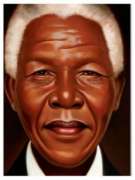
In this picture book biography, award-winning author and illustrator Kadir Nelson tells the story of Mandela, a global icon, in poignant free verse and glorious illustrations. It is the story of a young boy’s determination to change South Africa, and of the struggles of a man who eventually became the president of his country by believing in equality for all people, no matter the color of their skin. Readers will be inspired by Mandela’s triumph and his lifelong quest to create a more just world.
An author’s note at the back retells the story of Mandela’s fight against apartheid in simple prose, and takes the story further, including Mandela’s Nobel Peace Prize. A short bibliography lists additional sources for readers who want to find out more.
- ISBN: 9780061783746
- Author: Nelson, Kadir
- Published: 2013, Katherine Tegen Books
- Themes: presidents
- Descriptors: Biography - Autobiography- Memoir, Picture Book, Primary (ages 6-9), South Africa
- No. of pages: 40

Kristy
I really liked being able to read about Nelson Mandela after our discussion of We Are All Born Free and Declaration of Human Rights. Remember we talked Article 3 “We all have the right to life, and to live in freedom and safety” and Niki Daly’s illustration of “Freedom Park” which had a statue of Nelson Mandela. It was interesting to me that there were only a few nations that did not sign The Declaration of Human Rights and South Africa was one of those nations because of apartheid.
Kathleen
Interesting. I liked that we talked about the illustrations last time and would like to start with illustrations with Nelson Mandela.
Kristy
Kadir Nelson is an amazing artist – I think the illustrations really embodied so many different aspects of Mandela’s biography from a young boy in rural South Africa to his time as an activist and prisoner to his presidency.
Kathleen
This could easily be a wordless picture book. I think Kadir Nelson does an unbelievable job with his use of light and shadows to exemplify aspects of each illustration. For example, there is an illustration depicting a community meeting in Mandela’s boyhood village. Nelson uses light to convey the emotions that must have been felt at this meeting – sadness, loss, and uncertainty.
Kristy
The illustrations are reminiscent of Chris Soentpiet who illustrated a picture book about Booker T. Washington and another entitled Coolies (Yin, 2003). Similar to Nelson, Soentpiet use light to convey emotion and very serious subject matter.
Kathleen
If I were using this book in a classroom, I would walk students through the pictures without the text. Then read the epilogue. The interesting part for me was the back matter. I really appreciate the pictures to tell the story, I needed the pictures.
Kristy
I would start with the epilogue – I think it introduces or reminds readers about the importance of Mandela to the global community. Then I would want students to explore primary source materials connected to South Africa in the twentieth century (suggestion: Robben Island, or The District Six Museum, and to Mandela’s life.
Kathleen
Knowing about Mandela’s life is essential. I think it is important to know how long Mandela was imprisoned.
Kristy
I agree, he was imprisoned for 27 years – really a lifetime! Yet, Mandela lived what seemed a lifetime both before and after he was imprisoned. For example, what did you think about the two-page spread with the pyramids?
Kathleen
You know, I didn’t really attend to this page. I am not sure if the illustration is not supporting the text. How powerful is the text on this page. I needed the illustration to be more engaging.
Kristy
Interesting point. As I am looking back through the book, this is the only illustration in which there are no people visible.
Kathleen
And, each illustration of a person or people is very intimate.
Kristy
I agree, in many cases it is almost as if one or more of the people are looking directly at the reader. Like after Mandela is released from prison, Nelson has Winnie Mandela off to the left and it is as if Winnie is looking right at you.
Kathleen: I felt Mandela was looking right at me in the two-page spread describing his work when he was underground fighting for equality.
Kristy
I think this brings us back to the illustration of the pyramids. This is really important historical point that Mandela’s work was not confined to South Africa – he sought information and help from others across the African continent and the world.
Kathleen
I think it was really interesting about how hard he worked for three groups of people to live equally and in harmony. For example from Mandela’s speech, “We must forget our terrible past and build a better future for South Africa. Let’s fight for justice and walk the last mile to freedom.”
Kristy
I think this message transcends South Africa and maybe even Mandela in thinking about how we fight for justice near and far.
Kathleen
Locally, it is similar to the fight for so many urban children who live in poverty and are not privileged to have access to the same type of education children just a few miles away might have.
Kristy
This book and Mandela’s story provides opportunities to discuss civil rights. More generally, to tell these stories and actions that Mandela embodies.
Other Related Texts: AS we discussed this book, we could not help but connect to other texts. We have provided a list of a few of these texts:
Books
Long Walk to Freedom: The Autobiography of Nelson Mandela (1995)
Nelson Mandela a life in photographs by David Elliot Cohen
Movies
Mandela: Long walk to Freedom (film – 2013)
Music
Sweet Honey and the Rock
Free Nelson Mandela by The Specials